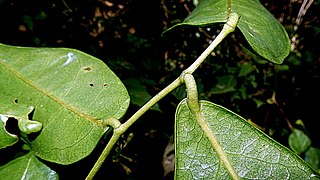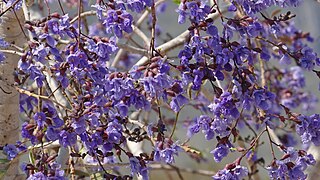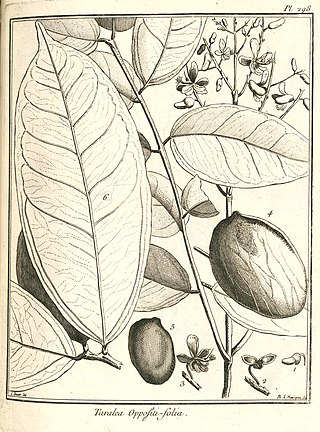
Zollernia is a genus of flowering plants in the legume family, Fabaceae. It includes 10 species native to South America, ranging from Venezuela and the Guianas to southern Brazil. Zollernia are trees or shrubs that flower annually. Species are most commonly found in dense moist forests, but also grow in seasonally-dry cerrado and caatinga.

Diplotropis is a genus of trees. It includes ten species native to northern South America, ranging from Colombia and Venezuela to Bolivia and west-central and southeastern Brazil.

Myrocarpus is a genus of flowering plants in the family Fabaceae. It includes five species of trees native to tropical South America, ranging from Venezuela to northern Argentina. Typical habitats include wet to seasonally-dry tropical lowland forest and woodland.

Poecilanthe is a genus of flowering plants in the family Fabaceae. It includes 9 species of trees and shrubs native to eastern, southern, and west-central Brazil, Bolivia, Paraguay, Uruguay, and northeastern Argentina. They grow in seasonally-dry tropical forest, woodland, thicket, and riverine forest.

Amicia is a genus of flowering plants in the legume family, Fabaceae. It includes seven species which are native to Mexico, Panama, Ecuador, Peru, Bolivia, and northwestern Argentina. It belongs to the subfamily Faboideae, and was recently assigned to the informal monophyletic Adesmia clade. It is named in honor of the Italian astronomer, mathematician and microscopist Giovanni Battista Amici (1786–1863).

Bowdichia is a genus of flowering plants in the legume family, Fabaceae. It belongs to the subfamily Faboideae. The genus includes two species native to tropical South America and Costa Rica.
Pterocarpus dubius is a species of flowering plant in the family Fabaceae native to Venezuela, Guyana, and northern Brazil in northern South America.
Fissicalyx fendleri is a species of flowering plant in the legume family, Fabaceae. It is a tree native to the tropical Americas, ranging from Panama through Colombia, Venezuela, and Guyana to northern Brazil. It grows in humid lowland forest.

Harpalyce is a genus of flowering plants in the family Fabaceae. It belongs to the subfamily Faboideae. It includes 35 species of shrubs and small trees native to the tropical Americas. Their distribution is disjunct, ranging from Mexico to Nicaragua, Cuba, and northern to southeastern Brazil and Bolivia. Typical habitats include seasonally-dry tropical forest, warm-temperate humid forest, woodland, bushland and thicket, shrubland, and grassland. Most species are evergreen and flower during the dry season.

Holocalyx balansae is a species of flowering plant in the legume family, Fabaceae. It belongs to the subfamily Faboideae. It is the only member of the genus Holocalyx. It is a tree native to South America, where it ranges from eastern, southern, and west-central Brazil to Bolivia, Paraguay, and northeastern Argentina.

Hymenolobium is a genus of flowering plants in the family Fabaceae. It includes 14 species of trees native to Central America and northern South America, ranging from Honduras to Bolivia and southeastern Brazil. Most species are native to Brazil, the Guianas, and Venezuela, with one extending into Peru, another into Ecuador, and one native to Central America. Trees are typically very tall and emergent in tropical humid lowland rain forest.
Monopteryx is a genus of flowering plants in the family Fabaceae. It includes three species of trees native to the Amazon rainforest of northern South America, ranging through parts of Colombia, Venezuela, northern Brazil, and French Guiana. They grow in non-inundated lowland tropical rain forest on sandy soil. The genus belongs to subfamily Faboideae. Members of this genus produce hydroxypipecolic acids in their leaves.
Nissolia, the yellowhoods, is a genus of lianas in the legume family, Fabaceae. It includes 32 species native to the tropical and subtropical Americas, ranging from Arizona and Texas through Mexico, Central America, and South America to northern Argentina. It belongs to the subfamily Faboideae, and was recently assigned to the informal monophyletic Adesmia clade of the Dalbergieae.
Rhynchotropis is a genus of flowering plants in the legume family, Fabaceae. It includes two species of herbs native to the Democratic Republic of the Congo, Angola, and Zambia. Typical habitats include seasonally-dry tropical woodland and wooded grassland in the northern Zambezian region, often in seasonally-damp or open sandy and rocky areas. It belongs to tribe Indigofereae of subfamily Faboideae.
Riedeliella is a genus of flowering plants in the legume family, Fabaceae. It includes three species of scandent shrubs native to Paraguay and eastern and west-central Brazil. They grow in seasonally-dry tropical forest, cerrado, and caatinga. The genus belongs to the subfamily Faboideae, and was recently assigned to the informal monophyletic Pterocarpus clade within the Dalbergieae.

Smithia is a genus of flowering plants in the legume family, Fabaceae. It includes 20 species of herbs or subshrubs native to sub-Saharan Africa, the Indian subcontinent, Indochina, southern China, Japan, Malesia, and northern Australia. The greatest diversity of species is in the Indian subcontinent, with 11 endemic species. Six more are widespread in southern and eastern Asia, and two of these, S. conferta and S. sensitiva, range further to northern Australia. Two species are endemic to sub-Saharan Africa. S. elliotii is native to Madagascar as well as mainland Africa, and S. conferta is also native to Madagascar. Typical habitats include seasonally-dry tropical grassland, wetlands, and streamsides.
Soemmeringia semperflorens is a species of flowering plants in the legume family, Fabaceae. It is the only member of the genus Soemmeringia.

Taralea is a genus of flowering plants in the family Fabaceae. It includes five species of trees and shrubs native to northern South America, ranging from Colombia and Peru to Venezuela, the Guianas, and northern and northeastern Brazil. Habitats include riverine and inundated tropical lowland rain forest, seasonally dry forest, woodland, and marsh. One or two species are also found in montane forest and in open moist woodland and scrub on sandstone-derived soils. It belongs to subfamily Faboideae.

Vatairea is a genus of flowering plants in the legume family, Fabaceae. It includes eight species of tall trees native to the tropical Americas, ranging from southern Mexico to Bolivia and southern Brazil. Seven species are native to northern South America, with the center of diversity in Amazonia. Vatairea lundellii ranges from southern Mexico to Panama. Most species grow in tropical rain forest, often in the inundated forests known as igapó and varzea, where they are emergent trees, growing above the forest canopy. V. macrocarpa grows in seasonally-dry forest, cerrado, and caatinga.
Vataireopsis is a genus of flowering plants in the legume family, Fabaceae. It includes four species of small to emergent trees, native to northern South America, ranging from Colombia, Venezuela, and the Guianas to Bolivia and southern Brazil. They grow in tropical lowland rain forest, in both the Amazon and Atlantic Forest.












